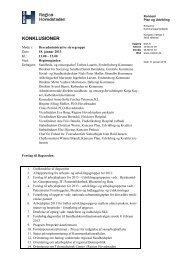Territorial Review Copenhagen - Region Hovedstaden
Territorial Review Copenhagen - Region Hovedstaden
Territorial Review Copenhagen - Region Hovedstaden
Create successful ePaper yourself
Turn your PDF publications into a flip-book with our unique Google optimized e-Paper software.
129<br />
whose aim is to construct a bottoms-up cross-border region in order to<br />
become more internationally competitive. This project has rightly been<br />
described as unique and innovative, with the potential to become a<br />
significant engine of growth for both Denmark and Sweden (OECD/IMHE,<br />
2006). The partnership network of the Øresund University will however<br />
have to be more inclusive and operational in a practical sense. There is room<br />
for more integration between the different institutions in terms of design and<br />
delivery of teaching and learning programmes, research projects and<br />
innovation and entrepreneurship initiatives. Students could be engaged more<br />
by regional internships, teaching and research projects and by increasing<br />
student mobility through supporting student travelling costs (OECD/IMHE,<br />
2006). Internationalisation strategies could beneficially be pursued from an<br />
Øresund angle.<br />
Education of immigrants<br />
The national government and the City of <strong>Copenhagen</strong> have recognised<br />
the need for better educational performance by immigrants. Immigrant<br />
students are at least as well provided as the native-born with traditional<br />
school resources such as class size, teacher-student ratios, language lessons<br />
per week, physical and educational infrastructure, and computer access at<br />
school. This reflects the compensatory allocation of resources in the Danish<br />
school system for schools with large numbers of immigrant students.<br />
Attracting and retaining qualified teachers to disadvantaged schools has<br />
become increasingly important in a labour market as tight as the market for<br />
teachers in the Capital <strong>Region</strong>. This could be accomplished by increasing<br />
the return for taking a job in these schools (e.g. by a mark-up in wages). The<br />
leeway provided by national regulations for such policies is, however,<br />
currently limited. 6<br />
Immigrant children have few incentives to perform. Teachers‘ academic<br />
expectations, encouragement and pressure to achieve are less favourable at<br />
schools attended by immigrant students. Peer composition at schools<br />
attended by immigrant students is potentially less conducive to academic<br />
achievement (Rangvid, 2006). Strengthening the culture of achievement at<br />
schools with high concentrations of immigrant students is a promising<br />
approach for reducing gaps, as well as tackling the segregation of ethnic<br />
minorities at the school level.<br />
Segregation at schools is related to spatial segregation. In Denmark,<br />
each public school has a fixed catchment area, and in principle, the local<br />
schools recruit their pupils from the surrounding residential neighbourhoods<br />
and should have the same ethnic profile as the residential population.<br />
However, students can apply to enrol to any other public school in the

















